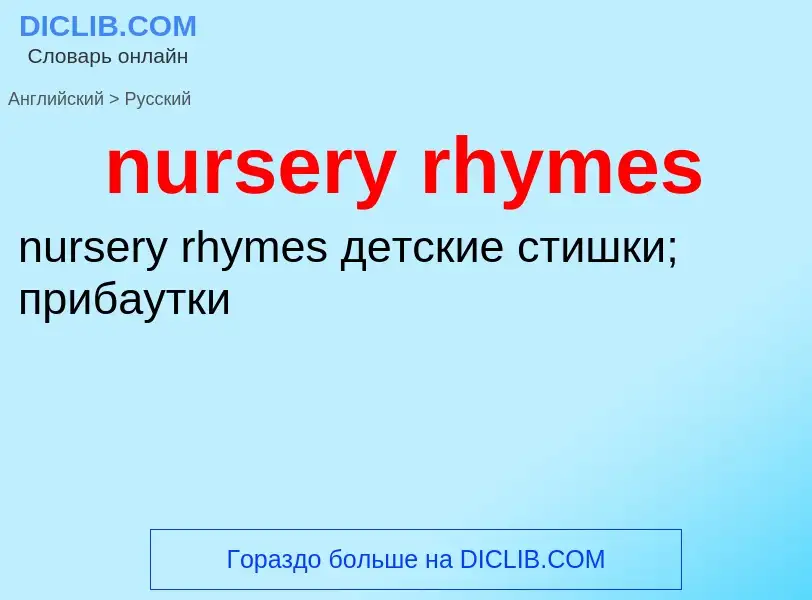Translation and analysis of words by artificial intelligence
On this page you can get a detailed analysis of a word or phrase, produced by the best artificial intelligence technology to date:
- how the word is used
- frequency of use
- it is used more often in oral or written speech
- word translation options
- usage examples (several phrases with translation)
- etymology
nursery rhymes - translation to English
['nə:strɪraɪmz]
общая лексика
дет-ские стишки (изобилуют фольклорными образами, отражают народные традиции и легенды, их основные персонажи: Шалтай-болтай [Humpty Dumpty], старый король Коул [Old King Cole], Джек и Джилл [Jack and Jill])
детские стишки
побасёнки
прибаутки
Definition
Wikipedia

A nursery rhyme is a traditional poem or song for children in Britain and many other countries, but usage of the term dates only from the late 18th/early 19th century. The term Mother Goose rhymes is interchangeable with nursery rhymes.
From the mid-16th century nursery rhymes begin to be recorded in English plays, and most popular rhymes date from the 17th and 18th centuries. The first English collections, Tommy Thumb's Song Book and a sequel, Tommy Thumb's Pretty Song Book, were published by Mary Cooper in 1744. Publisher John Newbery's stepson, Thomas Carnan, was the first to use the term Mother Goose for nursery rhymes when he published a compilation of English rhymes, Mother Goose's Melody, or, Sonnets for the Cradle (London, 1780).


!["[[Baa, Baa, Black Sheep]]", from a 1901 illustration by [[William Wallace Denslow]] "[[Baa, Baa, Black Sheep]]", from a 1901 illustration by [[William Wallace Denslow]]](https://commons.wikimedia.org/wiki/Special:FilePath/The Black sheep illustrated by William Wallace Denslow.jpg?width=200)
!["[[Three Blinde Mice]]" (1609), published by [[Thomas Ravenscroft]].<ref>Thomas Ravenscroft., ''Deuteromelia or The Seconde part of Musicks melodie, or melodius Musicke. Of Pleasant Roundalaies;'' Printed for Thomas Adams (1609). "Rounds or Catches of 3 Voices, #13" ([https://archive.org/stream/pammeliadeutrome12rave#page/n95/mode/2up Online version])</ref> "[[Three Blinde Mice]]" (1609), published by [[Thomas Ravenscroft]].<ref>Thomas Ravenscroft., ''Deuteromelia or The Seconde part of Musicks melodie, or melodius Musicke. Of Pleasant Roundalaies;'' Printed for Thomas Adams (1609). "Rounds or Catches of 3 Voices, #13" ([https://archive.org/stream/pammeliadeutrome12rave#page/n95/mode/2up Online version])</ref>](https://commons.wikimedia.org/wiki/Special:FilePath/Three Blinde Mice three voice round Deuteromelia 13 (1609).png?width=200)
